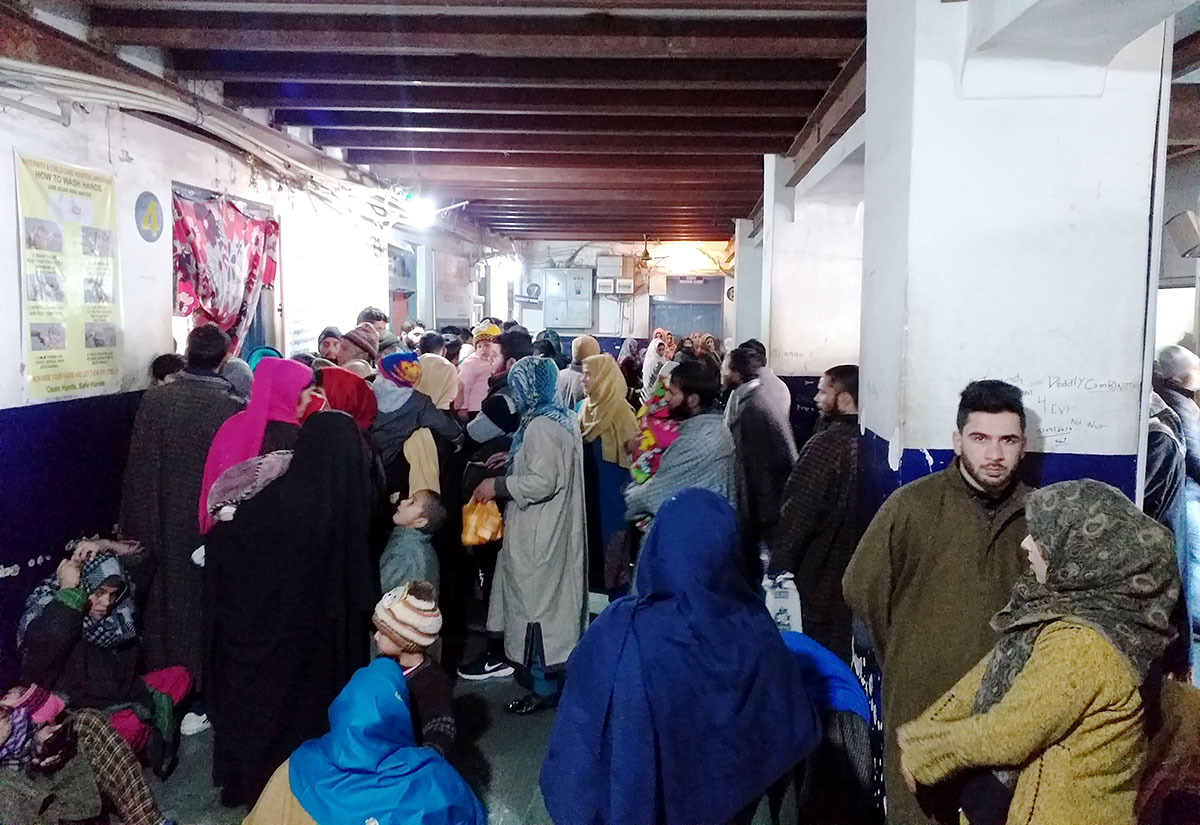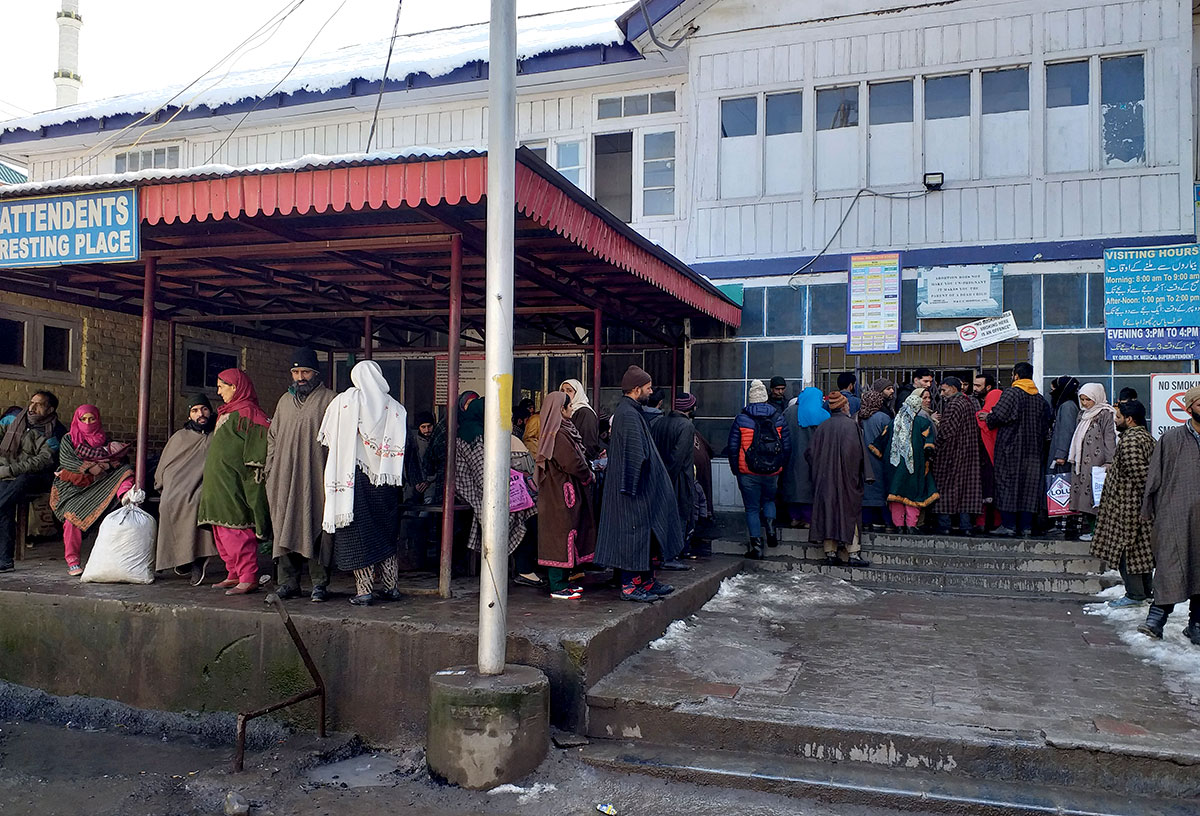As South Kashmir’s main maternity hospital operates from a rundown building, the mothers and the new born have to co-exist with rodents along with the staff. The hospital can be managed better if it shifts to the new space, reports Umar Khurshid

Patients outside the Block A’s OPD section. KL Image by Shah Hilal
Sharing the fear, attendants of two expectant mothers inside the snow-covered lawn of Anantnag’s Maternity and Child Hospital (MCH), are suggesting each other to remain vigilant during the night. “What are you people discussing,” asked the third female attendant sitting on their right. “The big rats, right?”
The two attendants Rozy, 32, and Zubaida, 36, of a Kokernag village are discussing ways and means to stay awake during the night fearing the rats roaming in good numbers might bite them. “We will ask two more attendants to join us for the night talks,” Zubaida suggested her sister-in-law Rozy. Joined by the third attendant, Gulshana 45, of Seer village near Mattan, the trio is terrified to sleep at a place where rats leave attendants frightened.
On December 16 morning, Zubaida and Rosy brought their pregnant sister-in-law to the hospital where she delivered a healthy baby. Later the patient was shifted from the Labour Room to an inside ward. The same evening, the tired duo thought to relax for some time. “As soon as we spread a plastic mat on the floor, a big rat ran next to my pillow,” Zubaida recalls. Same night, around 2 AM, two more bulky rodents joined the first one. Nobody in the ward could sleep. For the four nights, they would live with cries: Yeki Ha, Houtnus (It is here, there).
In the same ward was an elderly attendant Hjira of Liddru-Pahalgam. Doctors suggested her to wait till the ward is sanitized; an early morning process by the hospital’s cleaning staff.
Two days back, her daughter Jozia, 23, complained of labour pain and she was shifted to MCH Anantnag. On the first night inside the ward the mother and daughter had their introduction to the bulky rodents that shocked and surprised them.
As days passed, Hajira became so used to the rats that one day she said she couldn’t judge whether it is garbage heap or a rat. She actually stepped on the mouse and ran away.
Standing outside the Block B where hospital’s blood bank is located, a tall statured Mushtaq Ahmed Khan, 55, of Chittergul Anantnag is waiting for his wife and daughter. His daughter Shahnaza, 23, suffered blood loss in delivery. She was rushed to the MCH, where she was being treated for two days.
At the dead of the night, after Khan saw a brick sized rat, he alerted his wife. “Till the morning, we both couldn’t sleep to ensure a proper care to our daughter and her newly born baby,” Khan said. Mehjabeena, 37, of Aishmuqam is doing the same guard duty for her sister Sami, 26, admitted in Block B. “It was as if I had been put on the duty to keep the award rat free,” Mehjabeena said.
The building that houses the MCH was declared unsafe by the departments of R&B and Fire and Emergency decades before but it continues to operate with 100-beds, which at any point of time are occupied by more than 200 mothers. Built in 1956, the hospital has suffered cracks at many places. Fearing a collapse of block A, authorities used a lot of steel to support it. “If anything happens like collapsing of the slab or anything, I guess that would cause harm to hundreds of the people,” an official who wished to be anonymous said.
Block A is the first building not far away from the main gate. This block has paediatric section with a separate ward and OPD for child care, a Gynaecology and NHRM section. “Besides a general lab, we have a separate OPD in Gynaecology ward,” said an official. “There is an immunization facility at NHRM section as well.”
The L-shaped block B is swarmed by patients outside general wards, radiology section, labour rooms, blood bank, and the operation theatre. Every patient is accompanied by at least three attendants.
One of them is Adil Yusuf whose sister was admitted in the general ward last night. “I was supposed to give some blankets and warm cloths to my sister but I was not allowed to meet her till afternoon,” said Adil who was made to wait for hours outside the maternity ward.
Admitting that the rodents are a menace, a senior official said the main reason is the hospital’s old structures. “Rats often attack on old material and so is the MCH Anantnag,” he said.
The official said he and the patients have co-existed with the rodents ever since he was posted in the hospital almost a decade back. The hospital gives contract to the Rat Killer Operation Team who sanitizes the area thrice in twelve months. “It is a very costly process, not sure but it might be costing around Rs 40000, per turn,” the official said. “Once the operation is over, the rodents return.”
But this is not the only problem that the hospital is facing. Despite catering to most of south Kashmir and Pir Panchal, it even lacks space for parking the vehicles. “We have some six ambulances and believe me we don’t have space for those vehicles either,” the official said. “How will we deal with the private traffic?” This space is usually occupied by hundreds of attendants also.
Many times, when hospital witnesses a huge rush, extra beds are being installed in the corridor. “See it is a critical care hospital and referring patients to LD or somewhere doesn’t seem feasible in this situation,” the official said. Location of the hospital in a congested locality is yet another crisis. “Many times our ambulances get stuck in the jam and it takes hours to get out from the congestion.”
Outside the block A, where from immunization, OPD, family welfare, casualty and triage sections operate; Superintendent Dr Syed Mirchi Andrabi’s office has his office. It also remains inundated with the people.
Dr Andrabi said his hospital caters to the people beyond Anantnag district. “We serve the patients belonging to south Kashmir districts and Pir Panchal also,” he said. “Despite having the capacity of 100 beds we have the occupancy of 300 beds at present.”

A huge rush of patients, attendants outside Block B’s radiology ward section. KL Image by Shah Hilal
Andrabi said people often blame the MCH without understanding our compulsions. “How would we refuse entry to a patient?” explains a senior doctor sitting next to Andrabi. Terming the lack of space a major problem, the superintendent said the building is very old forcing the patients as well as the staff to face inconvenience.
“We cannot refer an expecting mother in that juncture to reach Srinagar,” Andrabi said. “And if we do so and something untoward happens to her, the blame would come to our head.”
The hospital was supposed to shift to Rehmat Aalam Hospital in Sarnal locality in September but the post August situation delayed the process. The government had earlier started the process of taking over the new premises in 2015 but the sanction was accorded only in 2017. The delay in completion of Rahmat-e-Alam hospital spread over 29 kanals and 17 marlas of land and shifting of MCH has left both the medicos and the locals fuming. The new premises suffered delay, at one point of time, because part of it was occupied by the security forces.
Doctors said they are operating the facility in trying situation: there are three patients to every bed; no ventilation; massive attendant crowds. “Sometimes, we try to operate patients who otherwise require to go to Srinagar,” one doctor said. “No doctor would ever harm a patient because we know as long as patients are safe, doctors are safe.”
from Kashmir Life https://ift.tt/2slkg7l
via IFTTThttps://kashmirlife.net
No comments:
Post a Comment